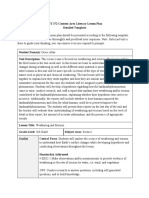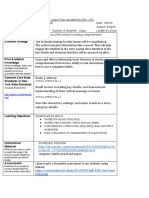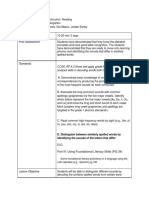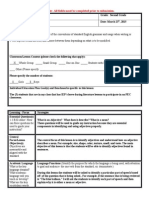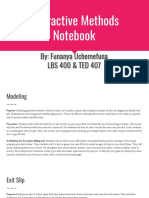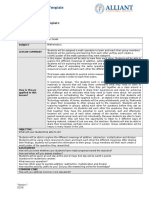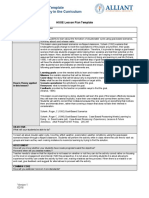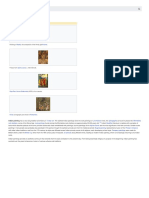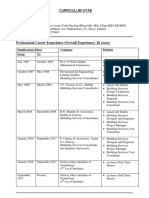TPA 2 - Reflection
TPA 2 - Reflection
Uploaded by
mmorris21Copyright:
Available Formats
TPA 2 - Reflection
TPA 2 - Reflection
Uploaded by
mmorris21Copyright
Available Formats
Share this document
Did you find this document useful?
Is this content inappropriate?
Copyright:
Available Formats
TPA 2 - Reflection
TPA 2 - Reflection
Uploaded by
mmorris21Copyright:
Available Formats
Meghan Rice TPA Reflection Professor Randall Hansen November 9, 2012
1. In the instruction seen in the clip(s), describe strategies you used to engage students in learning tasks to develop skills and strategies to comprehend or compose text. a. Cite examples of strategies aimed at engaging all your students and examples aimed at engaging specific individuals or subgroups. If you described any of these fully in the lesson plans or the planning commentary, just reference the relevant description.
During the learning segment, I directly taught for approximately the first three minutes of the lesson. I used a hook to engage the students in their learning prior to fully introducing the topic. I told them that great writers consult with other writers about their work. I shared with them how I collaborate with my mentor and my co-resident before I create my lesson plans. By having conversations with other people, I am able to see how I can add to my writings to make them better. For the past few lessons, the students watched me and Ms. Crosby (my coresident) model strategies on how to implement the writing strategies that we covered in our unit. Each day, I also used a personal piece and added details to my writings. The lesson that was planned for the 16th of October was designed to teach the students how to have conversations with their writing partners. An anchor chart was made and written in student friendly language to give the students a springboard of topic questions. Our writing units over the course of the year have been centered on learning to write and use the same strategies that authors use. One of those key strategies was to learn how to speak with other writers to improve their own writings. Before releasing the students into their respective groups, time was allotted for the students to ask questions/and or give a connection about the information that was just taught to them. Finally, at the end of the clip, the students were being
released into their Think, Pair, and Share (TPS) groups to ask and respond to at least one question from our anchor chart. b. How did these strategies reflect students academic or language development, social/emotional development, or cultural and lived experiences?
One of the things that helped to meet the varying needs of my students was to have consistency from day to day within the lessons that were being taught. I teach students in a self-contained classroom setting. Our students tend to have more permanence of knowledge and/or skills through repetition. Each day I added to my own personal writings and I modeled the specific strategy that the learners were being taught. By incorporating happenings from my childhood into my writings, creating anchor charts, discussing the content with the students, allowing them to work with peers, and finally, working independently was a way for me to make sure that I was providing concrete learning opportunities and the proper scaffolding that they needed to be successful as they were sent out on their own. When writing the questions onto the anchor chart, I was sure to use student friendly language. I also kept in mind the need to push their current language skills by providing some tier 2 vocabulary terms that were embedded within some of the questions that partners could ask one another. Two of the words that I wanted my students to focus on were the following: setting and characters. We have been building these into our vocabularies daily especially during Reading Workshop. I wanted the students to be able to transfer their knowledge of the term and use within the context of writing. Many of students based on their backgrounds, language needs, and lived experiences, need more support in the area of learning how to ask an actual question. Often times they confuse connections, comments, leading questions, or demonstrative statements as being questions. By showing and telling the students what a question sounds like and how it should be asked was in place to help support their understanding and use of how to effectively ask questions. 2. Cite examples of language supports seen in the clip(s) to help your students understand that content and/or participate in literacy discourse central to the lesson. a. How did these strategies reflect students varying language proficiencies and promote their language development?
In relation to the format of the questions that were written on the board, they
were constructed in a way that was palatable to my students who have both expressive and receptive language disorders. Each question, based on their current levels, was developmentally appropriate for the learners. Some of the questions were in place to ask for those surface level inquiries so that my younger students could learn how to participate and ask questions that were clear and understandable, especially when they were partnered with an older learner. Depending on what the students observed from their partners writing pieces, the learners could also ask questions that required deeper levels of thought like, How were you feeling in your story? or What made you write your story? By allowing the students to ask questions prior to beginning our TPS activity they were able to have them reconstructed in a way that allowed them hear how to rephrase their suggestions and actually mold them into questions. If my emergent readers were not able to read the words that were on the chart, they could model how to properly ask a question to a peer based upon recall. 3. Describe strategies for eliciting student thinking and how your ongoing responses further their learning. Cite examples from the clip(s). In my lesson plan, time was set aside for the students to work together as partners in place to allow them to formulate thoughts and ideas that could help push their writings. I referenced our anchor chart and questions that were asked during our mini discussion to help remind them of what the purpose of our TPS was. Alluding back to our making meaning discussion, I made sure to validate and address their statements/suggestions by telling them what kind of questions they were making an effort to present to me. 4. Reflection a. Reflect on students learning of concepts and academic language as featured in the video clip(s). Identify both successes and missed opportunities for monitoring all students learning and for building their own understanding of skills and strategies for comprehending and/or composing text. During the I Do portion of the lesson, I think that that after I read all of my questions, I missed the opportunity of going back and checking for understanding. I also could have had the students repeat the correct responses on how to ask a question to our writing partners. I think that incorporating a modeling session, prior to the teaching point was valuable to the students. It is important that they see and hear how to have a conversation that is productive, respectful, and on task. Though the clip did not show this piece, we also had a debriefing on what an appropriate conversation should look like. In doing so, we referenced our small group rules anchor chart.
b. If you could do it over, what might you have done to take advantage of missed opportunities or to improve the learning of students with diverse learning needs and characteristics? If I could do it all over again I would definitely have more checks for understanding. I would ask various students what the expectations of small group interactions looked like and for them to relay some ideas for questions that we could ask our peers, and if that child needed help, I could ask another student or provide options for the student, then have that child repeat the information aloud. Ultimately, I want to make sure that each student is supported to the best of their ability. Looking back to my videos, I feel as if I should have done a mini lesson on question words, this would have been done prior to this lesson and then reviewed during this lesson. If the children are able to have layers of skill sets and strategies to help them to navigate through conversations, then they will be more successful both in and out of the classroom. By having more of a formidable use of language and its varying structures, this will help to improve their reading, writing, and obviously their communicative skills.
You might also like
- Cal Tpa Doc CDocument4 pagesCal Tpa Doc Capi-655362605No ratings yet
- Task 2Document5 pagesTask 2api-708067647No ratings yet
- Danielson LP 12.6Document5 pagesDanielson LP 12.6Melissa MielkoNo ratings yet
- Introduction To The Guest SpeakerDocument2 pagesIntroduction To The Guest SpeakerLeodigaria Reyno95% (75)
- Case Studies in Interdisciplinary ResearchDocument2 pagesCase Studies in Interdisciplinary ResearchAdolfo HuamanNo ratings yet
- Teachers Guide Lower Secondary Science PDFDocument141 pagesTeachers Guide Lower Secondary Science PDFUbaid Ullah100% (1)
- Science Lesson PlanDocument6 pagesScience Lesson Planapi-347975424No ratings yet
- Content Area Lesson PlanDocument10 pagesContent Area Lesson Planapi-583719242No ratings yet
- Cycle 1 Compass MapsDocument4 pagesCycle 1 Compass MapsLori KallNo ratings yet
- Ted 410 Math LessonDocument9 pagesTed 410 Math Lessonapi-486956371No ratings yet
- Lesson Plan Form: CCSS - ELA-Literacy - RF.K.3.cDocument3 pagesLesson Plan Form: CCSS - ELA-Literacy - RF.K.3.capi-403088205100% (1)
- RainbowfishlessonplanDocument5 pagesRainbowfishlessonplanapi-341402633No ratings yet
- Student Teaching - Water Cycle Lesson 1Document2 pagesStudent Teaching - Water Cycle Lesson 1api-346526495No ratings yet
- People Interacting: 150 Activities to Promote Self Awareness, Communication, Social and Problem-Solving SkillsFrom EverandPeople Interacting: 150 Activities to Promote Self Awareness, Communication, Social and Problem-Solving SkillsNo ratings yet
- Lesson Foundation: Title and # Within Unit Grade LevelDocument4 pagesLesson Foundation: Title and # Within Unit Grade Levelapi-344731850No ratings yet
- TPA 1 - Ariel PalenciaDocument23 pagesTPA 1 - Ariel PalenciaArielNo ratings yet
- Lbs 405 5e Lesson Plan RationaleDocument3 pagesLbs 405 5e Lesson Plan Rationaleapi-457177416No ratings yet
- Mini Lesson Plan 7Document3 pagesMini Lesson Plan 7api-260889954100% (1)
- Lesson Plan Ted 508Document4 pagesLesson Plan Ted 508api-486161267100% (1)
- Lesson PlanDocument8 pagesLesson Planapi-440401318No ratings yet
- Learning Segment-Ela 3Document10 pagesLearning Segment-Ela 3api-254944388No ratings yet
- Siop - Science Lesson Plan 5th GradeDocument4 pagesSiop - Science Lesson Plan 5th GradeReginald JacksonNo ratings yet
- Tpa 4 000-49-3178Document24 pagesTpa 4 000-49-3178api-34917213888% (8)
- MLK Di Lesson PlanDocument8 pagesMLK Di Lesson PlanAndrea MonzonNo ratings yet
- Cep Lesson Plan TemplateDocument12 pagesCep Lesson Plan Templateapi-557959565No ratings yet
- Studentteaching Ela Edtpa LessonplanDocument8 pagesStudentteaching Ela Edtpa Lessonplanapi-301667326No ratings yet
- ITL 520 Assignment 4 SampleDocument15 pagesITL 520 Assignment 4 SampleTimothy GeyerNo ratings yet
- Schrecengost Itl 518 Learning MapDocument6 pagesSchrecengost Itl 518 Learning Mapapi-488269992100% (1)
- Edtpa UnitDocument15 pagesEdtpa Unitapi-237782390No ratings yet
- Five Senses Lesson Plan HeadstartDocument5 pagesFive Senses Lesson Plan Headstartapi-457866839No ratings yet
- Edtpa Lesson PlansDocument12 pagesEdtpa Lesson Plansapi-34049548767% (3)
- Fall 2018 Ela Edtpa Lesson Plan 1Document5 pagesFall 2018 Ela Edtpa Lesson Plan 1api-327064630No ratings yet
- Lesson Plan #2Document6 pagesLesson Plan #2Jason DonaldsonNo ratings yet
- F Uchemefunaresponsiveteachingandclassroommanagementplan Lbs 302 Management PlanDocument16 pagesF Uchemefunaresponsiveteachingandclassroommanagementplan Lbs 302 Management Planapi-434100129No ratings yet
- Tpe 4 SummaryDocument3 pagesTpe 4 Summaryapi-334624586No ratings yet
- ELD Levels/can Do Descriptors, Etc.) : This Lesson Is Intended For Use in A 9th Grade ELADocument18 pagesELD Levels/can Do Descriptors, Etc.) : This Lesson Is Intended For Use in A 9th Grade ELADanahNo ratings yet
- Section Threepart1Document29 pagesSection Threepart1api-418542426No ratings yet
- EDU 512 Reading Notes Format - Tompkins - (Patterns of Practice)Document4 pagesEDU 512 Reading Notes Format - Tompkins - (Patterns of Practice)api-550356295No ratings yet
- 5thgr Lesson Plan Day 1-2Document3 pages5thgr Lesson Plan Day 1-2api-24181950550% (2)
- CT 3 Lesson PlanDocument10 pagesCT 3 Lesson Planapi-531622341No ratings yet
- Edci 463 Udl Lesson Plan Template PsDocument8 pagesEdci 463 Udl Lesson Plan Template Psapi-535077017No ratings yet
- 4th Grade NC Symbols Lesson PlanDocument7 pages4th Grade NC Symbols Lesson Planapi-25041716967% (3)
- 1st Grade ELA Lesson 3Document7 pages1st Grade ELA Lesson 3Jessica KalvaitisNo ratings yet
- Smith Task1 LPDocument20 pagesSmith Task1 LPapi-270543710No ratings yet
- Intasc Standard 1 Learner DevelopmentDocument7 pagesIntasc Standard 1 Learner Developmentapi-253456954No ratings yet
- Kainrath Edtpa Early Childhood Planning Commentary RepairedDocument4 pagesKainrath Edtpa Early Childhood Planning Commentary Repairedapi-3091896210% (1)
- Final Edtpa Direct Lesson Plan DwilliamsDocument3 pagesFinal Edtpa Direct Lesson Plan Dwilliamsapi-295821640100% (1)
- Reading Notes 7Document4 pagesReading Notes 7api-550356295No ratings yet
- Ted 407 Lbs 400 Interactive Methods Notebook 1Document13 pagesTed 407 Lbs 400 Interactive Methods Notebook 1api-434100129No ratings yet
- Unit Plan 1-5Document21 pagesUnit Plan 1-5api-326620154No ratings yet
- Artifact 5 - Iep AnalysisDocument7 pagesArtifact 5 - Iep Analysisapi-518903561No ratings yet
- First Grade Lesson PlanDocument3 pagesFirst Grade Lesson Planapi-312965587No ratings yet
- Reading Notes CH 4-5Document5 pagesReading Notes CH 4-5api-510621758No ratings yet
- Alliant Hsoe Lesson Plantemplate Goal-Based LessonDocument4 pagesAlliant Hsoe Lesson Plantemplate Goal-Based Lessonapi-534596308No ratings yet
- Udl Lesson Plan 2 1Document4 pagesUdl Lesson Plan 2 1api-657969654No ratings yet
- History-Social Science, Grade 3: Date: July 7, 2021 Candidate: Leigh Anteola Context/Grade LevelDocument3 pagesHistory-Social Science, Grade 3: Date: July 7, 2021 Candidate: Leigh Anteola Context/Grade Levelapi-557514903No ratings yet
- Pre-Observation Questions - PeerDocument6 pagesPre-Observation Questions - Peerapi-258317089No ratings yet
- Task 1: Planning Commentary: 1. Central FocusDocument4 pagesTask 1: Planning Commentary: 1. Central FocusNicole WalstromNo ratings yet
- Reading Notes 2Document3 pagesReading Notes 2api-550356295No ratings yet
- Teacher Work Sample Final 2Document55 pagesTeacher Work Sample Final 2api-348361949No ratings yet
- Winners Never Quit Lesson PlanDocument6 pagesWinners Never Quit Lesson Planapi-315049671No ratings yet
- Indian PaintingDocument9 pagesIndian PaintingxiaoboshiNo ratings yet
- Assignment of Environmental Studies: Submitted To: Mrs. Thasneema M. Kabir Submitted By: Jinson Raju 3 YearDocument9 pagesAssignment of Environmental Studies: Submitted To: Mrs. Thasneema M. Kabir Submitted By: Jinson Raju 3 YearJanet VargheseNo ratings yet
- Thomas Lyons CVDocument6 pagesThomas Lyons CVapi-458243291No ratings yet
- Research I: Quarter 3 - Module 2: Probability and Non-Probability SamplingDocument32 pagesResearch I: Quarter 3 - Module 2: Probability and Non-Probability SamplingZenyx MLNo ratings yet
- UntitledDocument45 pagesUntitledWS KNIGHTNo ratings yet
- Corporate EntrepreneurshipDocument19 pagesCorporate EntrepreneurshipShuvro Rahman100% (1)
- Hvac Resume 3 PDFDocument6 pagesHvac Resume 3 PDFfatREVITNo ratings yet
- Unit 3 - Job InterviewsDocument26 pagesUnit 3 - Job InterviewsQi YouNo ratings yet
- Recto Memorial National High School: Number of LearnersDocument1 pageRecto Memorial National High School: Number of LearnersRay Jay DipasupilNo ratings yet
- An Example Interview Protocol FormDocument5 pagesAn Example Interview Protocol FormdeanNo ratings yet
- Current Event RubricDocument2 pagesCurrent Event Rubricapi-271264056No ratings yet
- Dcu Dissertation GuidelinesDocument7 pagesDcu Dissertation GuidelinesHelpWithPaperUK100% (1)
- Agriculture Is The Process of Producing FoodDocument2 pagesAgriculture Is The Process of Producing FoodNickay PNo ratings yet
- English Literature As Level Coursework ExamplesDocument5 pagesEnglish Literature As Level Coursework Examplesbotav1nakak3100% (2)
- Lesson Plan 7. Farm Plans and Layout BergadoDocument8 pagesLesson Plan 7. Farm Plans and Layout BergadoJenny MocorroNo ratings yet
- Assessment in The Affective Domain: Reporting in Test and MeasurementDocument9 pagesAssessment in The Affective Domain: Reporting in Test and MeasurementremardocorNo ratings yet
- For The Private Sector/IndustryDocument2 pagesFor The Private Sector/IndustryCarolyn vestidasNo ratings yet
- Personal Statements vs. Statements of Purpose PPT PDFDocument11 pagesPersonal Statements vs. Statements of Purpose PPT PDFshambelNo ratings yet
- Armstrong & Hauser 2009Document30 pagesArmstrong & Hauser 2009Sandra Janeth Santacruz SilvaNo ratings yet
- 2nd Annual Fee Notification Tech Education 2024abDocument2 pages2nd Annual Fee Notification Tech Education 2024absunnydhillon258036No ratings yet
- Theories of EthicsDocument32 pagesTheories of EthicsNhật TàiNo ratings yet
- The Historic Voice of Bukid A Postcolonial Reading of Manila andDocument207 pagesThe Historic Voice of Bukid A Postcolonial Reading of Manila andChristian L AcostaNo ratings yet
- Research Paper MidtermDocument3 pagesResearch Paper MidtermCabildo, Neil Andrei T.No ratings yet
- b3 SyllabusDocument4 pagesb3 Syllabusapi-302697554No ratings yet
- Department of Education: Republic of The PhilippinesDocument3 pagesDepartment of Education: Republic of The PhilippinesCarlo Precioso100% (2)
- Applied Stream: NOTE: Your Application Form Has Submitted Successfully. Your Payment Is SuccessfulDocument3 pagesApplied Stream: NOTE: Your Application Form Has Submitted Successfully. Your Payment Is Successfulinfweb4735No ratings yet
- Chapter 3Document7 pagesChapter 3MohamadZakri100% (1)







